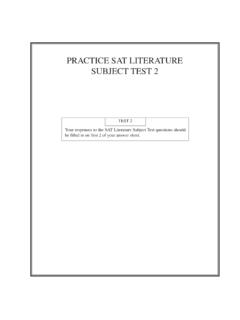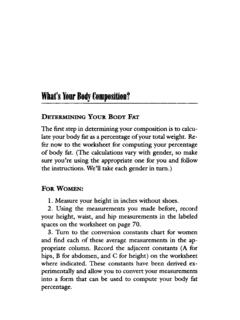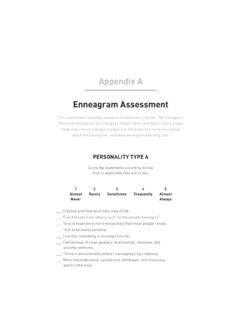Transcription of PRACTICE SAT CHEMISTRY SUBJECT TEST 2 - Random House
1 PRACTICE SAT CHEMISTRYSUBJECT TEST 2 You are about to take the second PRACTICE SAT CHEMISTRY SUBJECT answering questions 1 23, which constitute Part A, you ll be directed to answer questions 101 116, which constitute Part B. Then, begin again at ques-tion 24. Questions 24 69 constitute Part you re ready to score yourself, refer to the scoring instructions and an-swer key on pages 292 294. Full explanations regarding the correct answers to all questions start on page SAT CHEMISTRY SUBJECT Test 2 | 277GO ON TO THE NEXT PAGE MATERIAL IN THE FOLLOWING TABLE MAY BE USEFUL IN ANSWERING THE QUESTIONS IN THIS SUBJECT TESTDsRgPERIODIC TABLE OF THE ELEMENTSDO NOT DETACH FROM BOOK. 278 | Cracking the SAT CHEMISTRY SUBJECT TestCHEMISTRY SUBJECT TEST 2 ContinuedGO ON TO THE NEXT PAGENote: For all questions involving solutions and/or chemical equations, assume that the system is in pure water unless otherwise ADirections: Each set of lettered choices below refers to the numbered statements or questions immediately following it.
2 Select the one lettered choice that best fits each statement or answers each question, and then fill in the corresponding oval on the answer sheet. A choice may be used once, more than once, or not at all in each 1 4 refer to the following.(A) Molarity(B) Molality(C) Mole fraction(D) Density(E) Partial pressure 1. Is measured in units of atmospheres or millimeters of mercury 2. Is measured in units of moles/kilogram 3. Is a measure of mass per unit volume 4. Is the quantity used in the calculation of boiling point elevationQuestions 5 9 refer to the following.(A) Hydrogen bonding(B) Ionic bonding(C) Network bonding(D) London dispersion force(E) Metallic bonding 5. Chiefly responsible for the relatively high boiling point of water 6.
3 Is present in liquid oxygen 7. Is primarily responsible for the hardness of diamond 8. Allows copper to conduct electricity 9. Is present in solid KClCHEMISTRY SUBJECT TEST 2 PRACTICE SAT CHEMISTRY SUBJECT Test 2 | 279 CHEMISTRY SUBJECT TEST 2 ContinuedGO ON TO THE NEXT PAGEQ uestions 10 13 refer to the following.(A) Na+(B) Al(C) F(D) Ti(E) Br 10. Has 7 valence electrons 11. Has the electron configuration 1s22s22p63s23p1 12. Has the same electron configuration as a neon atom 13. Has valence electrons in d orbitalsQuestions 14 17 refer to the following.(A) A solution of HNO3(B) A solution of HC2H3O2(C) A solution of Cu(NO3)2(D) A solution of NaNO3(E) A solution of NaOH 14.
4 Will be colored blue 15. Will have a pH of 2 16. Will have the lowest freezing point 17. Will contain undissociated aqueous particles 280 | Cracking the SAT CHEMISTRY SUBJECT TestCHEMISTRY SUBJECT TEST 2 ContinuedGO ON TO THE NEXT PAGEQ uestions 21 23 refer to the following.(A) Ionization energy(B) Electronegativity(C) Atomic radius(D) Atomic number(E) Mass number 21. Is the measure of the pull of the nucleus of an atom on the electrons of other atoms bonded to it 22. Is the energy required to remove an electron from an atom 23. Is equal to the number of protons in an atomQuestions 18 20 refer to the following.(A) Enthalpy change(B) Entropy change(C) Gibbs free energy change(D) Activation energy(E) Specific heat capacity 18.
5 Is the amount of energy that must be added to raise the temperature of 1 gram of a substance 1 C 19. Its value indicates the spontaneity of a reaction 20. Its value indicates whether a reaction is endothermic or exothermicPractice SAT CHEMISTRY SUBJECT Test 2 | 281 CHEMISTRY SUBJECT TEST 2 ContinuedGO ON TO THE NEXT PAGE I IIPart BDirections: Each question below consists of two statements, I in the left-hand column and II in the right-hand column. For each question, determine whether statement I is true or false and whether statement II is true or false,and fill in the corresponding T or F ovals on your answer sheet. Fill in oval CE only if statement II is a correct explanation of statement I. EXAMPLES:SAMPLE ANSWERSIEX 1.
6 H SO is a strong acid BECAUSE H SO contains 2. An atom of oxygen is electrically neutral BECAUSE an oxygen atom contains an equal number of protons and 1EX 2 TFTFTFTFI II CE 101. An ionic solid is a good conductor BECAUSE an ionic solid is composed of positive of electricity and negative ions joined together in a lattice structure held together by electrostatic The bond in an O2 molecule is BECAUSE the oxygen atoms in an O2 moleculenonpolar share the bonding electrons When a sample of water freezes, BECAUSE ice is at a lower potential the process is exothermic energy state than At 25 C, an aqueous solution with BECAUSE the pH of a buffered solution is not a pH of 5 will have a pOH of 9 greatly affected by the addition of a relatively small amount of acid or When a chlorine atom gains an BECAUSE a neutral atom has equal numbers of electron.
7 It becomes a positively protons and electrons. charged ion106. Lithium has a larger first ionization BECAUSE oxygen atoms have larger atomic radii energy than oxygen than lithium Potassium chloride dissolves readily BECAUSE water is a polar solvent. in waterPLEASE GO TO THE SPECIAL SECTION LABELED CHEMISTRY AT THE LOWER RIGHT-HAND CORNER OF THE ANSWER SHEET YOU ARE WORKING ON AND ANSWER QUESTIONS 101 116 ACCORDING TO THE FOLLOWING DIRECTIONS. 282 | Cracking the SAT CHEMISTRY SUBJECT TestCHEMISTRY SUBJECT TEST 2 ContinuedGO ON TO THE NEXT PAGE108. Ammonia is a Lewis base BECAUSE ammonia can donate an electron pair to a Elemental fluorine is more reactive BECAUSE neon has a larger atomic weight than elemental neon than The addition of a catalyst will decrease BECAUSE a catalyst provides an alternate reaction the DH for a reaction pathway with a lower activation The oxygen atom in a water molecule BECAUSE water molecules exhibit hydrogen has a 2 oxidation state bonding.
8 112. When a salt sample dissolves in water, BECAUSE for a salt sample, aqueous ions have S for the process is positive greater entropy than ions in a When the temperature of a reaction at BECAUSE at equilibrium, all reactants have equilibrium is increased, the been converted into products. equilibrium will shift to favor the endothermic direction114. An atom of 12C contains 12 protons BECAUSE the identity of an element is determined by the number of protons in the nuclei of its Water boils at a lower temperature at BECAUSE the vapor pressure of water is lower high altitude than at low altitude at higher Elemental sodium is a strong BECAUSE an atom of elemental sodium gives reducing agent up its valence electron readily.
9 RETURN TO THE SECTION OF YOUR ANSWER SHEET YOU STARTED FOR CHEMISTRY AND I IIPractice SAT CHEMISTRY SUBJECT Test 2 | 283 CHEMISTRY SUBJECT TEST 2 ContinuedGO ON TO THE NEXT PAGEANSWER QUESTIONS 24 CDirections: Each of the questions or incomplete statements below is followed by five suggested answersor completions. Select the one that is best in each case and then fill in the corresponding oval on the answer sheet. 24. What is the oxidation state of bromine in HBrO3?(A) 3(B) 1(C) +1(D) +3(E) +525. What is the percent by mass of silicon in a sample of silicon dioxide?(A) 21%(B) 33%(C) 47%(D) 54%(E) 78%26. How many electrons does a 37Cl ion with a charge of 1 contain?(A) 16(B) 17(C) 18(D) 37(E) 38CH4(g) + 2 O2(g) CO2(g) + 2 H2O(g) + 800 kJ27.
10 If 1 mole of O2(g) is consumed in the reaction given above, how much energy is produced?(A) 200 kJ(B) 400 kJ(C) 800 kJ(D) 1,200 kJ(E) 1,600 kJ28. Which of the following is NOT true of the element sodium?(A) It takes the oxidation state +1.(B) It reacts with water to form a basic solution.(C) It forms metallic bonds in its solid uncombined form.(D) It is found in nature as a diatomic gas.(E) It reacts with a halogen to form an ionic What volume of a solution of sodium hydroxide is required to neutralize 40 liters of a hydrochloric acid solution?(A) 10 liters(B) 20 liters(C) 40 liters(D) 60 liters(E) 120 liters .. PH3 + .. O2 .. P2O5 + .. H2O30. When the equation above is balanced and the coefficients are reduced to the lowest whole numbers, the coefficient for H2O is(A) 1(B) 2(C) 3(D) 4(E) 5 284 | Cracking the SAT CHEMISTRY SUBJECT TestCHEMISTRY SUBJECT TEST 2 ContinuedGO ON TO THE NEXT PAGE34.













